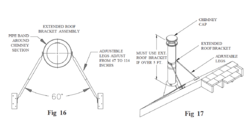Hello, everyone. Our chimney is on the windward side and catches a lot of prevailing wind. When it's really blowing it can push smoke back down the pipe and out the joints in the double-walled pipe. Any suggestions for reducing this? It doesn't happen often, but when the wind is just right, it pushes enough smoke out into the room to be irritating. I was wondering if there was maybe a fire-rated tape, or something I could seal the joints with? Or, any other approaches folks have found to work?
Thanks in advance.
Thanks in advance.


